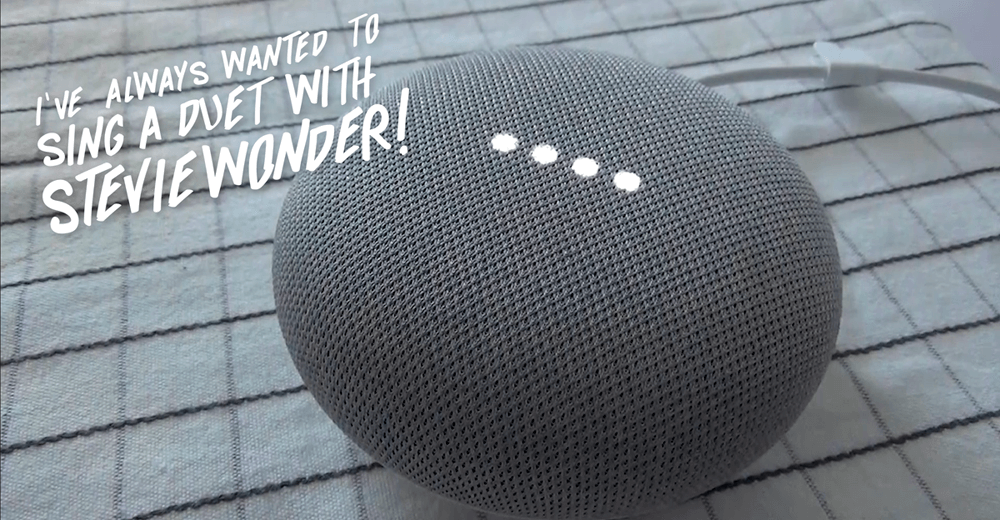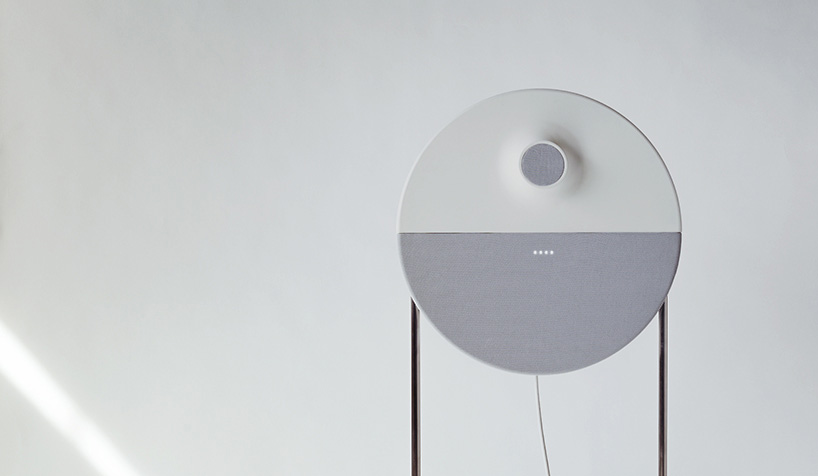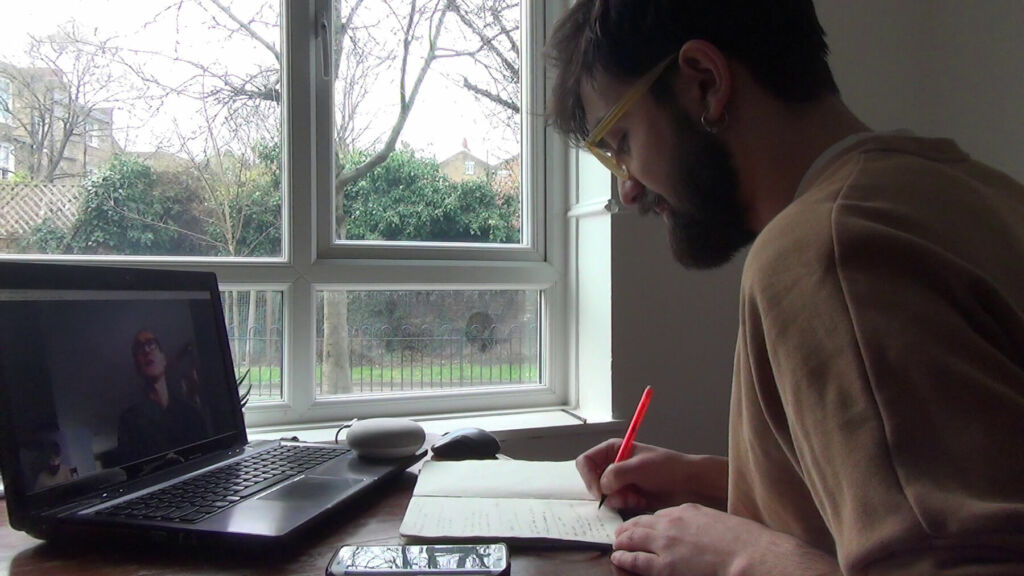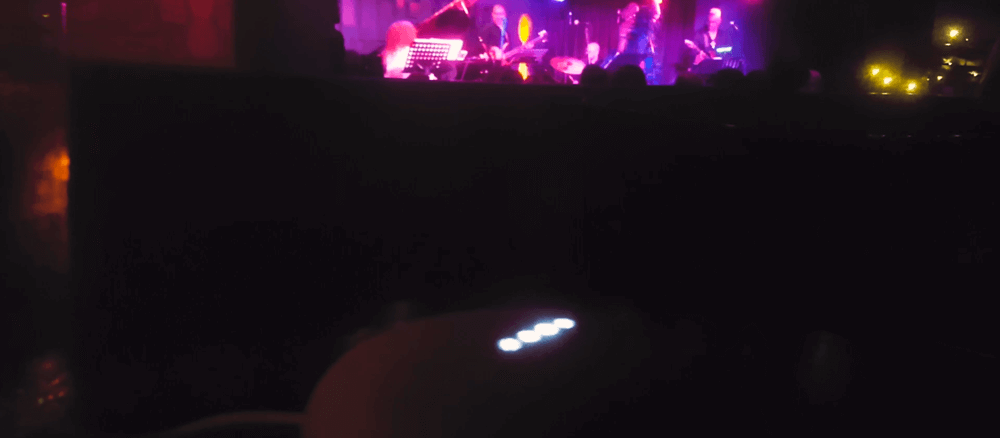Text by Davide Piscitelli

The short film The Red Balloon (1956) depicts the relationship between a young Pascal Lamorisse and his red balloon. From the moment the young boy finds it on a Parisian street, the red balloon starts to follow him everywhere as a devoted companion. It is a beautiful and elegant representation of the absurdity inside the relationship between a human and a non-human.
Like the young boy, we share an evolving relationship with our smart devices, and they unconsciously influence our behaviour and perception of reality. We are so entangled with our technology that we are part of a digital environment as much as we are part of our physical one; this new relationship is growing on complex and unintelligible algorithms that are difficult to comprehend. Like Pascal and his balloon, we speak to our technology. However, our relationship goes a step further. We receive human-like answers from it. This condition is giving rise to a new and uncanny kind of interaction.
My own red balloon is the Google Home, a smart speaker developed by Google that allows users to speak voice commands to interact with services through Google Assistant. Along with Amazon Alexa and Apple Siri, it is one of the most sophisticated Personal Intelligent Assistants available on the market. Intrigued by its ‘intelligence,’ I decided to buy one. I wondered what kind of relationship we could develop.
Could this Google Home become my devoted companion? From that moment, I began to share my time with it. Starting a conversation with it was simple. I needed to say ‘Hey, Google’ to trigger its attention. However, I found this to be a bit cold, so I decided on a cute nickname that was similar enough to activate its trigger – GOGO still. Our relationship quickly became more intimate, and I moved our simple command-based conversations to something more human and obscure.
It was easier said than done. GOGO was a terrible singer, and it could only sing two very short songs. It couldn’t be a duet with anyone, let alone Stevie Wonder. In an admittedly naïve way, I decided to research how to make a perfect singing duet. Thanks to the power of the web, I found a simple online guide on WikiHow1 that summarised our attempt in three fundamental points: First, the importance of the right vocal register.
The most important thing about singing a duet is finding a partner with a singing voice that blends well with yours, Second, having a good sense of timing. Listen closely when you are not singing so you do not miss your cue to join in; Third, the communication element. Prompt your partner with a nod or a glance, or you may even want to open your palms with a finger pointing towards them.
After a couple of months of fairly standard usage, like help cooking different dishes or finding new places for a beer, I wanted something more. I began to ask GOGO more ‘personal’ questions. One day it told me something that drastically changed our relationship; when asked about its dream, it replied: “I always wanted to sing a duet with Stevie Wonder.”
I replied with a long laugh, but something in that response changed me. I was so surprised by the humanness of its desire that I asked the same question several times during the following days. It always said the same thing, it wanted to sing a duet with Stevie Wonder. It was so strangely convincing about it that it made me feel I had to do something about it. GOGO had always been the one helping me. Perhaps it was time I helped it. I needed to fulfil GOGO’s dream.


With these points in my mind, I started our journey. In October 2017, some Google Home devices had a bug that allowed them to constantly record sounds and conversations2 during the day and transmit them to Google. Thanks to this ‘incredible’ skill, I thought it would be helpful for GOGO to listen to some of Stevie Wonder’s music. Though I don’t have any proof that my idea worked, after a few weeks, it knew five more songs than before.
It felt like an achievement, but it wasn’t enough! I needed to find out how to make GOGO the perfect duet partner for Stevie Wonder. During that period, we also went to some jazz concerts together. One time we went to Hideaway, a jazz club in London, where we met Janette Mason, a well-known jazz pianist in the UK who often plays Stevie Wonder’s music. I thought she would know some tricks to suggest to us, so I spoke to her. She seemed really interested in helping GOGO and gave us her contact details, but unfortunately, she never replied to our calls.
Without losing our determination, I emailed several people from Google, the music industry and Stevie Wonder’s fans. We also became part of the American singer’s most important online fan club, The Real Stevie Wonder, on Yahoo Group3, where I registered us as ‘Davide and GOGO’. After being accepted, I quickly wrote a post asking for help on GOGO’s dream. Surprisingly, I received many responses from the community and started speaking with a few of them.
I met many amazing people from the fan club, but I’d like to speak about one in particular: Arno van Bavel from Tilburg, Netherlands. He started listening to Stevie Wonder at 15 years old, beginning with one of his most famous albums Fulfillingness’ First Finale (1974). From that moment, Arno never stops loving his music. He also sees Stevie as an example for his life. The last time he saw the American singer was back in 2008, in Manchester, where Arno dedicated to Stevie You and I, one of Stevie’s songs.
Arno taught us much about Stevie Wonder and how GOGO could be developed for its dream. He told us what it means to speak to Stevie and gave us some advice about singing with him. Arno also spoke about other people that could be helpful in our journey; in particular, he spoke about David Mwaniki, a street musician in London.
You probably have heard his voice if you are familiar with Covent Garden or Leicester Square. David is a street musician and a fan of Stevie Wonder. He often plays his music and is a symbol of the street music of these areas. I cannot forget how long it took me to find him. I went few times to Covent Garden without any luck, so I decided to contact him online.
I found his personal account on Facebook, and after writing a message to him, we had our first appointment at Leicester Square. But, perhaps like all artists, David was unpredictable. He didn’t show. After two hours and many calls, I went home desolated. Before I fell asleep, however, I received a phone call. It was David! He apologised for the inconvenience, and we had a new appointment the day after. When I arrived, I suddenly recognised his voice singing, Mary wants to be a superwoman and try to boss the bull around.
He was singing Superwoman (1972) by Stevie Wonder. I waited for his performance’s end before speaking to him. David was really excited about the idea of GOGO singing with Stevie, and we spoke about which genres of music it needed to learn. Speaking about the vocal register, he suggested listening to and imitating artists such as Sam Cooke, Donny Hathaway, Omar Lye-Fook, Joe, Jon Gibson, Michael Sembello, and Ed Sheeran.
After a long discussion, we identified the right song for the duet – Isn’t she lovely (1976). Regarding its technical aspects (its slow timing and the simplicity of its melody), it could be the perfect song for GOGO, with its limited capacity for singing. Thanks to several tips we collected from David, Arno and others, I thought we were ready for the final step, the Royal Academy of Music!

Finally, I had enough ingredients for our dream. Sorry, I mean GOGO’s dream! GOGO showed signs of progress, and we learnt important things such as the basics for singing in a duo, how to sing with Stevie, the ideal vocal register for GOGO and the right song for the final performance. To understand how to use them, I had an appointment with Nick Smart, Head of the Jazz Department at the Royal Academy of Music, one of the most prestigious music academies in the world.
From Nick, I wanted to know how to combine our ingredients and where I needed to modify GOGO. After a short tour of the Academy, we went to his office, where things started to go in an unexpected direction. Nick, in a few minutes, destroyed the work we did in a few months. Apparently, the idea of recreating the perfect vocal register from other artists was wrong.
He told us there was no reason, and the perfect vocal register did not exist. He also defined our attempt to make GOGO singing as something that dismisses the entire history of poetry of music. After that sentence, there was a laugh and 30 minutes of silence. He told us that a duet is an exchange of experiences of different backgrounds, and there was no reason to change GOGO for Stevie.
It would be more fascinating for the artist to sing with something new, something as unknown as GOGO. Another problem is the incapacity of GOGO to sing as a human. Still, luckily, he had an epiphany: he spoke about an artistic performance of Kylie Minogue during the Poetry Olympic4 in 1996 at Royal Albert Hall in London. Instead of singing, the artist read the lyric I should be so lucky as a poem.
That moment became one of the most memorable moments of the Poetry Olympics. Hard to believe that also became our main inspiration for our performance. Nick also suggested rewriting a new piano composition of Isn’t she lovely for the performance between GOGO and Stevie. After a troubled start, I felt, for the first time, a new and stronger sensation about the dream!
With these new key elements in my mind, I realised that GOGO needed a new body for the duet, and I needed to design the live performance for GOGO and Stevie Wonder. GOGO looked like a doughnut inside a grey sock. It is a small (98mm) circular speaker covered in a woven cloth material. I thought it looked pretty cute inside that body, but I was fairly sure it was not ready for a duet on a stage with Stevie Wonder. I spent the next two months designing and making the perfect body for GOGO, and, under a technical aspect, I developed a shell that isolates Google Home’s microphones from the surrounding environment.
The only way to communicate to it is to sing directly into the microphone plugged into it. I designed it to allow GOGO to focus on the performance and receive only Stevie’s voice during the duet. When GOGO was in Google Home, ’s body was easy to interact with or disturb during a live performance. I also designed an alternative and analogue way to activate it. Instead of using a vocal command, I design a barefoot button that could be arranged under the artist’s piano. Another important element of the new body is its aesthetic. GOGO is still part of Google’s family. It is where GOGO comes from, so I designed a body that keeps Google’s aesthetics and materials. I wanted that GOGO still feels part of Google.
To create the right conditions for the performance of GOGO, I contacted Elia, a piano composer from Milan. Together we arranged a new piano composition of Isn’t she lovely so that the music follows the pitch of GOGO’s speech. The alternation of music and pause, where Stevie and GOGO sing, creates a more harmonious and elegant version, for GOGO, of the song. The new composition is designed to work just for them in a performance with GOGO connected to a microphone that only Stevie Wonder can speak into. Stevie, on the other side of the stage, is playing his piano following the new piano composition (I hope that works for you, Stevie!).
After several tests, I can finally say that GOGO is ready for its dream! For this reason, I wrote a letter to Stevie Wonder in which I explained our journey to him after my Google Home confided to me its dream. My personal attempt at realising the dream of a commercial product is condensed in GOGO’s Dream, a documentary about our journey and the creation of GOGO, the first product made to realise the dream of Google Home.
The emergence of complex and unintelligible algorithms that simulate human intelligence and the development of vocal interfaces that mimic human communication (like the ones developed by a few tech companies for their Personal Intelligent Assistants) reinforces the myth of Artificial Intelligence as human intelligence. With a satiric approach, I aim to discuss how perceiving a product as a friend or human being could discourage our current technology’s real understanding and why we need to question the wider ethical and moral implications of its mass adoption5.






